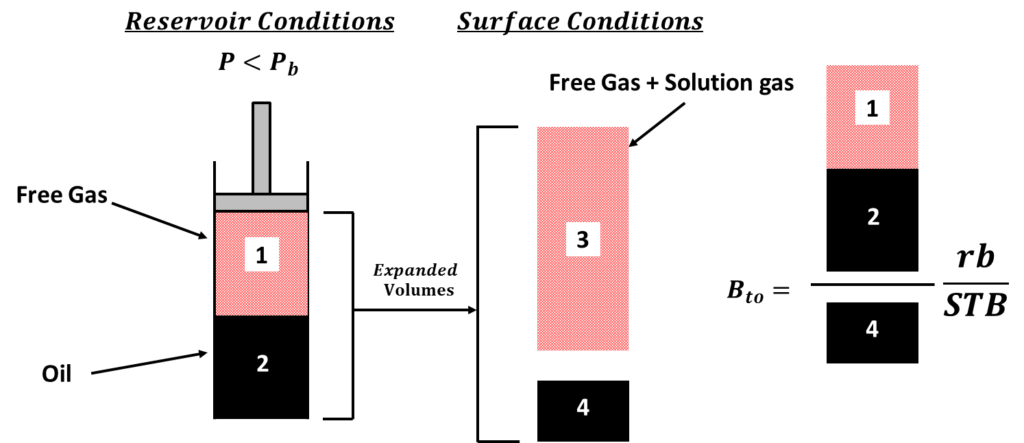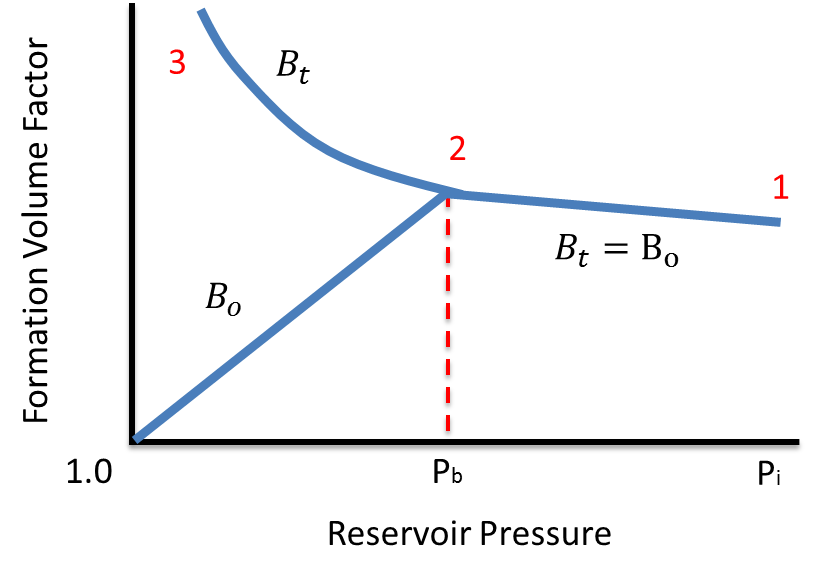So far we have considered reservoir pressures maintained above the bubble point. At reservoir pressures above the bubble point, only single phase oil exists. Below the bubble point, solution gas evolves out of the oil becoming free gas in the reservoir. When this occurs, the oil and gas coexist in the reservoir. When multiple phases exist, it becomes a little more difficult to characterize fluid production at the surface and keep track of the volumes. Luckily, petroleum engineers developed the two phase oil formation volume factor to account for both oil and free gas. An illustration of the two phase formation volume factor is shown below:

From the figure above it should be clear that the two phase oil formation volume factor (![]() ) is the total volume at reservoir conditions (liquid phase + gas phase) divided by its resulting oil-phase at standard conditions. Mathmatically, the two phase oil formation volume factor can be expressed as the following:
) is the total volume at reservoir conditions (liquid phase + gas phase) divided by its resulting oil-phase at standard conditions. Mathmatically, the two phase oil formation volume factor can be expressed as the following:
(1) ![]()
where ![]() is the oil formation volume factor ,
is the oil formation volume factor , ![]() is the solution gas oil ratio at the bubble point pressure,
is the solution gas oil ratio at the bubble point pressure, ![]() is the solution gas oil ratio, and
is the solution gas oil ratio, and ![]() is the gas formation volume factor. To use equation 1 properly,
is the gas formation volume factor. To use equation 1 properly, ![]() ,
, ![]() , and
, and ![]() need to be evaluated at the resulting pressure. Equation 1 shows that
need to be evaluated at the resulting pressure. Equation 1 shows that ![]() and
and ![]() are related. How they are related is pretty cool. The graph compares both formation volume factors as a function of pressure:
are related. How they are related is pretty cool. The graph compares both formation volume factors as a function of pressure:

The figure above shows how the the two phase oil formation volume factor compares to the oil formation volume factor as a function of pressure at constant reservoir temperature. The process can be described in steps:
- 1-2: Above the bubble point pressure, the oil formation volume factor and two phase oil formation volume factor are equivalent. This is because no free gas exists in the reservoir. Mathematically this can also be shown because at pressures above the bubble point the solution gas oil ratio is constant, therfore
 . Thus Equation 1 reduces to
. Thus Equation 1 reduces to  .
. - 2-3: As the reservoir pressure falls below bubble point pressure, the two phase oil formation volume factor and the oil formation volume factor begin to diverge tremendously. This is because free gas continuously gets liberated in the reservoir and
 decreases.
decreases.
Before you take off, it’s important to know the assumptions behind the two phase oil formation volume factor. The two phase oil formation volume factor assumes the overall composition to be equal to the initial free oil compositions. Thus if no free oil initially exists in the reservoir, e.g. an undersaturated gas reservoir, then ![]() is undefined and neglected from material balance calculations.
is undefined and neglected from material balance calculations.